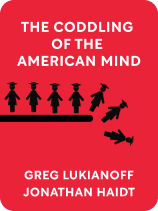

This article is an excerpt from the Shortform book guide to "The Coddling of the American Mind" by Greg Lukianoff and Jonathan Haidt. Shortform has the world's best summaries and analyses of books you should be reading.
Like this article? Sign up for a free trial here .
Why is the “us versus them” mindset so destructive? How has intersectionality contributed to the problem? In what ways have these problems contributed to call-out culture?
Jonathan Haidt and Greg Lukianoff, co-authors of The Coddling of the American Mind, discuss the three “Great Untruths” in modern society. The first of those untruths is the untruth of “us versus them.” In their book, they discuss where this mindset originated from and what the implications are.
Keep reading to learn what Haidt and Lukianoff have to say about the dangers of the “us versus them” mindset.
The World Is Black and White
In this article, we’ll explore the third untruth—that the world is defined by a black-and-white struggle between the forces of good and evil, or an “us versus them” mindset. This type of thinking is highly psychologically damaging to those who succumb to it and dangerous to academic freedom on campus.
In particular, we’ll examine:
- How recent high-profile protests against speakers on college campuses are indicative of a destructive “us versus them” mindset
- How academic discourses around concepts of repressive tolerance and intersectionality have inculcated a victimhood mentality in students
- How call-out culture (aided by social media) creates a chilling effect on college campuses that forces students, faculty, and administrators to self-censor
Us Versus Them
Psychological research shows that the human mind is hardwired to sympathize with members of our in-group and fear and distrust members of an out-group.
The most consequential human conflicts are those between groups—nation vs. nation, white vs. black, straight vs. LGBTQ, rich vs. poor, and so on. Despite our potential to think in terms of this us-against-them, black-and-white view of the world, this type of thinking often doesn’t inform our day-to-day interactions with other people.
Most of the time, we successfully navigate through life while working and sharing space with people from backgrounds different from our own. It often takes conflict or deliberate activation of this innate tribalism to force us to consciously think in terms of group difference and group identity.
Common-Humanity Identity Politics
Identity politics is a form of political mobilization based on some shared group characteristic, often race, ethnicity, nationality, gender expression, or sexual orientation. This is in contrast to traditional political mobilization, which is usually oriented around some shared material goal or interest (as with labor unions or an industry lobby).
There is nothing wrong with identity politics per se—people who share common identity characteristics usually do have interests in common, and it makes sense for them to band together to advance the causes they care about.
Identity politics can be affirming and constructive when they follow the common-humanity model, most famously practiced by the Reverend Dr. Martin Luther King, Jr. Although King was specifically fighting to address the legal, political, economic, social, and physical injustices faced by African-Americans since before the founding of the United States, he grounded his appeal in a universalist message that spoke to the nation’s shared sense of justice and decency.
In speaking to white Americans and to those who were skeptical of civil rights advances for African-Americans, King evoked the common “civic religion” of the United States, drawing upon the lofty rhetoric of the Declaration of Independence and the US Constitution. He cast the movement he led not as a battle of black Americans against white Americans, but as a struggle to uplift all Americans.
Common-Enemy Identity Politics
Common-enemy identity politics represents the opposite of King’s vision. It uses the alleged threat of a shared adversary to mobilize its supporters. Usually, the enemy is cast as an oppressor and the mobilized group casts itself as a marginalized population struggling to remove its shackles.
This form of identity politics is difficult to reconcile with the normal democratic process. After all, if one is fighting against an oppressor that threatens your very right to exist, to accept any compromise would be to accede to one’s own destruction. Almost any action can be justified when one adopts this mode of thinking.
Intersectionality
One idea that has particularly contributed to these patterns of thinking on campus is intersectionality.
Intersectionality is a theoretical framework that focuses on how systems of oppression can overlap and combine. For example, the racism that black men experience is not the same as the combined racism and sexism that black women experience. The overlapping, or “intersection,” of the two forms of prejudice experienced by black women is a unique phenomenon that must be addressed on its own terms.
Originally put forward by the feminist scholar Kimberlé Williams Crenshaw in 1989, intersectionality offers valuable insights, highlighting how systems of oppression can form a mutually interlocking web. It also helps the general public and policymakers identify sources of disadvantage that might otherwise go unnoticed.
As with identity politics, the problem is not with the idea of intersectionality itself. Rather, the way it is taught, interpreted, and applied in many academic settings encourages young people to view their life and daily interactions through the lens of oppression or privilege. This black-and-white, us-against-them mentality inhibits critical thinking and distorts how students view the world. Life is far more nuanced and complicated than a simple story of oppression vs. privilege.
According to the new understanding of intersectionality, everyone lives along an axis of oppression or privilege according to their identity (white or black, heterosexual or LGBTQ, rich or poor, and so on). Depending on where you happen to land on the axis, it becomes easy to engage in simplified black-and-white moral thinking, labeling straight white men as evil “oppressors” by virtue of their identity, and everyone else as virtuous “victims,” solely on the basis of their non-white, non-straight, non-male identity. This sort of tribal thinking can dangerously cloud one’s moral judgment.
These misapplications of intersectionality teach university students to see sources of difference as more important than sources of common ground, dividing the world up into the privileged and the oppressed.
“Fitting the Mold” at Claremont McKenna College
Under the influences of these and other theoretical frameworks, college campuses have been rocked by student-led protests, often directed at university professors and administrators.
At Claremont McKenna College, a female student of working-class, Latin-American background wrote an article in a student newspaper decrying the college’s lack of diversity and arguing that the culture on campus was primarily grounded in white, middle-class values that made it difficult for students like herself to fully feel a part of it.
In response, the dean of students reached out to the writer and expressed a desire to hear her perspectives on how to make the college a more inclusive and welcoming place for students who did not “fit the mold” at the college (this was the dean’s choice of words in her email).
The student chose to interpret the “fit the mold” comment as the dean telling her that she did not belong at the college—clearly the opposite message from what the dean intended. A full-scale protest against this dean and the university administration ensued, with students staging hunger strikes and demanding that the dean be fired.
Although the college did not fire her, the administration also offered no public defense of her, nor did many of her colleagues on the faculty. Ultimately, the dean resigned due to the stress and often-frightening harassment she faced on campus.
Call-Out Culture
One more outgrowth of this black-and-white approach to conflict is the growth of “call-out culture.”
Call-out culture is the public shaming of “oppressors” on campus, often for the most trivial offenses. Even the slightest deviations from left-wing orthodoxy (such as liking a “problematic” or “offensive” post on social media) can incite a vicious reaction. Social media makes call-out culture much more pervasive and cruel, as it gives the online attackers a sense of anonymity that allows them to relax their moral inhibitions—similar to how group psychology leads participants in mobs to engage in violent actions that they never would in one-on-one interactions.
Some perpetrators of call-out culture may privately feel that the actions of the digital mob are wrong; they nevertheless go along because they feel the need to signal to the group that they are on the “right” side of the conflict (this dynamic is known as virtue signaling).
Call-out culture has a chilling effect on free speech on campus, as students, faculty, and administrators are forced to resort to self-censorship out of fear of being socially vilified for politically incorrect opinions. This is especially dangerous in academic settings, which are supposed to be bastions of free speech and debate.
Ultimately, call-out culture and its harsh “us-against-them” psychology work against many of the goals of left-wing politics, because it alienates potential allies and radicalizes and mobilizes opponents. Columbia University professor Mark Lilla, who describes himself as a “once and future liberal,” argues that the left’s increased focus since the 1960s on sources of difference rather than points of commonality has been central to the Democratic Party’s withering electoral fortunes.
Systemic racism and other forms of marginalization really do exist, and it should be the mission of everyone who claims to be on the side of progress to oppose them. But by antagonizing would-be allies, focusing its ire on the wrong targets, and rooting itself in a politics of division, the modern left has locked itself into a self-defeating cycle. Instead, the left must build bridges, form broad coalitions with allies, and embrace a politics of inclusion.

———End of Preview———
Like what you just read? Read the rest of the world's best book summary and analysis of Greg Lukianoff and Jonathan Haidt's "The Coddling of the American Mind" at Shortform .
Here's what you'll find in our full The Coddling of the American Mind summary :
- The "three Untruths" that have taken hold of young people
- The damage that "speech codes" cause on college campuses
- How colleges are increasingly seeing students as customers






